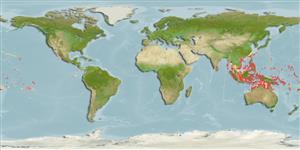Preferred temperature (Ref.
123201): 25.3 - 29, mean 28 °C (based on 226 cells).
Phylogenetic diversity index (Ref.
82804): PD
50 = 0.5002 [Uniqueness, from 0.5 = low to 2.0 = high].
Bayesian length-weight: a=0.00977 (0.00470 - 0.02030), b=3.07 (2.89 - 3.25), in cm total length, based on LWR estimates for this (Sub)family-body shape (Ref.
93245).
Niveau trophique (Ref.
69278): 3.4 ±0.41 se; based on food items.
Résilience (Ref.
120179): Haut, temps minimum de doublement de population inférieur à 15 mois (Preliminary K or Fecundity.).
Fishing Vulnerability (Ref.
59153): Low vulnerability (10 of 100).
Nutrients (Ref.
124155): Calcium = 102 [60, 178] mg/100g; Iron = 0.789 [0.458, 1.453] mg/100g; Protein = 18.4 [15.5, 20.6] %; Omega3 = 0.168 [0.105, 0.267] g/100g; Selenium = 24.3 [14.4, 44.2] μg/100g; VitaminA = 148 [46, 558] μg/100g; Zinc = 1.84 [1.26, 2.91] mg/100g (wet weight);
